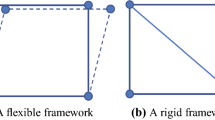Abstract
Formation control is studied for single-and double-integrators on the plane based on orientation alignment and position estimation. It is assumed that agents measure the relative positions of their neighbors with respect to their own local body-fixed reference frames without any common sense of orientation. The proposed control strategy consists of an orientation alignment, a position estimation, and a position control law. It is shown that the proposed control strategy allows the agents to achieve the desired formation if the interaction graph is uniformly connected and the orientation angles belong to an interval with arc length less than π.
Similar content being viewed by others
References
K.-K. Oh, M.-C. Park, and H.-S. Ahn, “A survey of multiagent formation control,” Automatica, vol. 53, no. 3, pp. 424–440, 2015. [click]
W. Ren and E. Atkins, “Distributed multi-vehicle coordinated control via local information exchange,” International Journal of Robust and Nonlinear Control, vol. 17, no. 10–11, pp. 1002–1033, 2007. [click]
Z. Lin, B. A. Francis, and M. Maggiore, “Necessary and sufficient graphical conditions for formation control of unicycles,” IEEE Transactions on Automatic Control, vol. 50, no. 1, pp. 121–127, 2005. [click]
L. Krick, M. E. Broucke, and B. A. Francis, “Stabilization of infinitesimally rigid formations of multi-robot networks,” International Journal Control, vol. 82, no. 3, pp. 423–439, 2009.
K.-K. Oh and H.-S. Ahn, “Formation control of mobile agents based on inter-agent distance dynamics,” Automatica, vol. 47, no. 10, pp. 2306–2312, 2011. [click]
M.-C. Park and H.-S. Ahn, “Distance-based acyclic minimally persistent formations with non-steepest descent control,” International Journal of Control, Automation, and Systems, vol. 14, no. 1, p. 163, 2016.
K.-K. Oh and H.-S. Ahn, “Leader-follower type distancebased formation control of a group of autonomous agents,” International Journal of Control, Automation, and Systems, vol. 15, no. 4, pp. 1783–1745, 2017.
X. Dong and G. Hu, “Time-varying formation control for general linear multi-agent systems with switching directed topologies,” Automatica, vol. 73, pp. 47–55, 2016. [click]
X. Dong, Y. Zhou, Z. Ren, and Y. Zhong, “Timevarying formation control for unmanned aerial vehicles with switching interaction topologies,” Control Engineering Practice, vol. 46, pp. 26–36, 2016. [click]
X. Dong, Y. Zhou, Z. Ren, and Y. Zhong, “Time-varying formation tracking for second-order multi-agent systems subjected to switching topologies with application to quadrotor formation flying,” IEEE Transactions on Industrial Electronics, vol. 64, no. 6, pp. 5014–5024, 2017. [click]
L. Wu, Y. Gao, J. Liu, and H. Li, “Event-triggered sliding mode control of stochastic systems via output feedback,” Automatica, vol. 82, pp. 79–92, 2017.
H. Yan, F. Qian, H. Zhang, F. Yang, and G. Guo, “H ∞ fault detection for networked mechanical spring-mass systems with incomplete information,” IEEE Transactions on Industrial Electronics, vol. 63, no. 9, pp. 5622–5631, 2016.
H. Zhang, X. Zheng, H. Yan, C. Peng, Z. Wang, and Q. Chen, “Codesign of event-triggered and distributed H ∞ filtering for active semi-vehicle suspension systems,” IEEE/ASME Transactions on Mechatronics, vol. 22, no. 2, pp. 1047–1058, 2017. [click]
H. Zhang, Q. Hong, H. Yan, F. Yang, and G. Guo, “Eventbased distributed H ∞ filtering networks of 2-dof quartercar suspension systems,” IEEE Transactions on Industrial Informatics, vol. 13, no. 1, pp. 312–321, 2017. [click]
Y. Dai and S.-G. Lee, “The leader-follower formation control of nonholonomic mobile robots,” International Journal of Control, Automation and Systems, vol. 10, no. 2, pp. 350–361, 2012. [click]
K.-K. Oh and H.-S. Ahn, “Formation control of mobile agents without an initial common sense of orientation,” Proceedings of the IEEE 51st Conference on Decision and Control, Maui, Hawaii, USA, 2012, pp. 1428–1432.
L. Moreau, “Stability of continuous-time distributed consensus algorithms,” Proceedings of the 43rd IEEE Conference on Decision and Control, Atlantis, Paradise Island, Bahamas, 2004, pp. 3998–4003.
K.-K. Oh and H.-S. Ahn, “Formation control of mobile agents based on distributed position estimation,” IEEE Transactions on Automatic Control, vol. 58, no. 3, pp. 737–742, 2013. [click]
P. Ioannou and J. Sun, Robust Adaptive Control, Prentice-Hall, 1996.
K.-K. Oh and H.-S. Ahn, “Formation control and network localization via orientation alignment,” IEEE Transactions on Automatic Control, vol. 59, no. 2, pp. 540–545, 2014. [click]
E. Kreyszig, Introductory Functional Analysis with Applications, Wiley and Sons, 1978.
Author information
Authors and Affiliations
Corresponding author
Additional information
Recommended by Associate Editor Hongyi Li under the direction of Editor Yoshito Ohta. Kwang-Kyo Oh was supported by the Korea Institute of Industrial Technology under the project No. EO180020. Hyo-Sung Ahn was supported by the National Research Foundation (NRF) of Korea under the grant NRF-2016M1B3A1A01937575.
Kwang-Kyo Oh received the Ph.D. degree in mechatronics from Gwangju Institute of Science and Technology, Gwangju, Korea, in 2013. He is with Korea Institute of Industrial Technology, Gwangju, Korea. His research interests are in the areas of control theory and applications with emphasis on cooperative control of multi-agent systems.
Hyo-Sung Ahn received the B.S. and M.S. degrees in astronomy from Yonsei University, Seoul, Korea, in 1998 and 2000, respectively, the M.S. degree in electrical engineering from the University of North Dakota, Grand Forks, in 2003, and the Ph.D. degree in electrical engineering from Utah State University, Logan, in 2006. Since July 2007, he has been with the School of Mechatronics, Gwangju Institute of Science and Technology (GIST), Gwangju, Korea. He is currently Professor and Dasan Professor. Before joining GIST, he was a Senior Researcher with the Electronics and Telecommunications Research Institute, Daejeon, Korea. He is the author of the research monograph Iterative Learning Control: Robustness and Monotonic Convergence for Interval Systems (Springer-Verlag, 2007). His research interests include distributed control, learning control, network localization, and autonomous navigation systems.
Rights and permissions
About this article
Cite this article
Oh, KK., Ahn, HS. Distributed Formation Control based on Orientation Alignment and Position Estimation. Int. J. Control Autom. Syst. 16, 1112–1119 (2018). https://doi.org/10.1007/s12555-017-0280-2
Received:
Revised:
Accepted:
Published:
Issue Date:
DOI: https://doi.org/10.1007/s12555-017-0280-2




